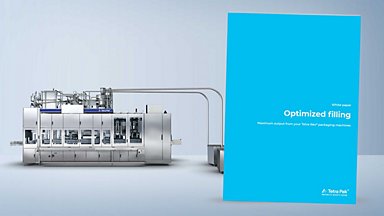Picture your perfect package. What does it look like? Elegant and eye-catching, for sure. Modern, perhaps? Or maybe something more timeless? Perhaps the graphical elements – fonts, images, colours – are bold and edgy, a beacon for the 21st Century; perhaps they’re a little more classical, conforming to the traditional norms of a particular food category. Either way, it definitely looks good. And for that, package printing plays a critical role.
“When we talk about ‘cost-efficient food packaging solutions’, you need to have a printing technology that’s quite efficient,” says Jonas Eklund, Design Prototype Expert at Tetra Pak. “But what is ‘efficient’ depends on exactly what you’re trying to do and the packaging material you’re using.” Existing printing technology runs from the basic – something like Tetra Pak® Flexo Line – to the cutting edge, with advanced options in terms of colours, shading, gradients and photorealism. But adds Eklund, “The technology doesn’t really decide the outcome. You can use something basic and be very creative, unique and modern, or take the best technology and create simple, classic designs.”
A variety of different technologies
Eklund likens the most basic package printing technology to potato printing – your design is turned into a series of rubber clichés, each dipped into one colour and then pressed onto the paperboard. “If your package material is quite rough, this is what you’d use,” he says. “It’s flexible and obviously cheaper, but you can still create unique and edgy designs using this method. For example, customers looking for a rustic, clean design can benefit from this technology, one example being many of Oatly’s packages.”
As the quality of your packaging material increases – as the surface gets smoother – you can achieve better print quality and greater control with better technology. Higher contrast, and a wider variety of colours, become possible; so too do greater depth in images and seamless gradients. Add CMYK colours to the process, for example with Tetra Pak® Sharp, and you can mix them into any shade or hue required. “And then you can create more gradients and images of fruits and food that look quite appetising,” says Eklund. “And with this print method, special colours can be used for logos and other elements that needs a consistent colour between print runs.”
The next step is mixing in additional spot colours to create more vivid pictures – with Tetra Pak® Select, for example, extra spot colours allow for halftone images and photographic designs to be more vivid. While more cutting-edge printing, such as Tetra Pak® Offset Palette, uses six or seven process colours to create the sharpest, most realistic images using the widest possible range of shades and hues. 12.9 billion, to be precise. “That’s useful when you want to create a design that really matches something, like a specific image or a precise colour,” says Eklund.
Choosing the best method for you
As to which works best for any given package or product, Eklund circles back to the idea of efficiency. Practicality too. “From a production point of view, it’s common to do co-printing to be as efficient as possible. But you have to consider this when creating designs because it can have a big impact.” This is because, aside from the CMYK, you only have two further spot colours to use for the whole roll (which might contain a number of different designs) – once you use them, you cannot add any more, potentially limiting what designs you can co-print.
“This can be a hassle when optimising production – you can easily run into problems,” Eklund adds. “But if you have something like Offset Palette, it takes the burden off the designer because you don’t have to spend a second thinking about it – you can mix and match the colours as much as you want.”
Eklund also notes that producers needn’t simply opt for the most advanced or best printing option available. “You can always play with different aspects,” he says. He recommends a holistic approach, taking into account precisely what package you’ve chosen, its size, the finish of the paperboard and the design cues of your product’s category. “Brands need to think about what they want to communicate to consumers and how to communicate it,” he adds. “So identify the key elements for your category and then, within that, explore what printing options you have to give you the most effective result.”
One important aspect of choosing a higher quality printing technology is flexibility, not just in terms of the design and the graphical elements, but in what becomes possible between packages with no colour limitations for each run. For example, if you want different designs on the side and back panels of your package – these create a better consumer interaction and engagement with the products – better print technology means you have a more comprehensive range of colours to choose from, giving your designers greater options and freedom.
Similarly, when it comes to personalisation or doing a small number of unique designs on packaging, having fewer issues with shades and hues is advantageous. Eklund cites the example of printing full-colour cartoon characters onto your existing design. “We can make these characters look very slick – they can be very impressive,” he says. “It’s a great way to connect with consumers and really stand out on the shelf.”
Consider your options from the very beginning
Ultimately, says Eklund, producers should take their chosen package, the packaging material, and the subsequent printing options into consideration before even starting to design. “The sooner you understand the limitations, possibilities, and opportunities, and what you have to work with as a designer, the better,” he says. “The worst that can happen is your designing team coming up with something that can’t be turned into reality without major compromises, so it’s crucial to know the parameters you have to operate in and base your design on that.”









